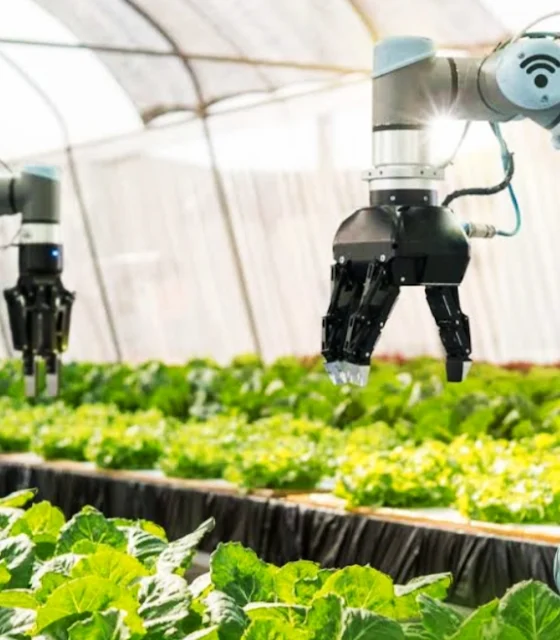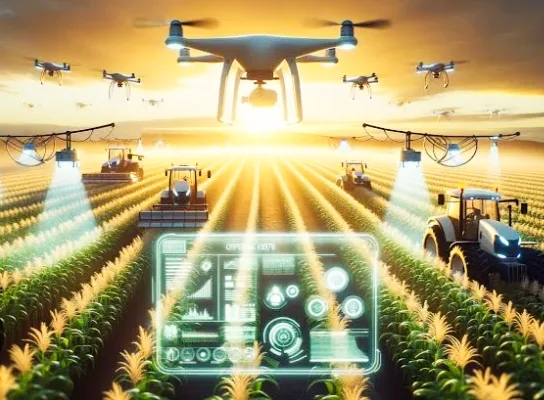The Global Landscape of Agritech: 20 Leading Countries
Agritech, the application of technology to agriculture, is transforming the way we grow food. From precision farming techniques to automated milking machines, agritech is helping to increase yields, reduce waste, and improve sustainability.
Key Parameters for Evaluating Investment in Agritech Countries
Here's a table outlining key parameters to consider when evaluating investment opportunities in the agritech sector of different countries:
| Parameter | Description | Importance for Investment |
|---|---|---|
| Government Support | Level of government funding, policies, and initiatives for agritech development | Strong government support can indicate a stable and favorable environment for agritech businesses. |
| Innovation Ecosystem | Presence of research institutions, universities, and startups focused on agritech | A vibrant innovation ecosystem fosters development of cutting-edge technologies and attracts talent. |
| Market Size & Growth | Size and growth potential of the domestic agricultural sector | A large and growing domestic market creates demand for agritech solutions. |
| Agritech Focus Areas | Areas of strength and specialization within the country's agritech sector | Aligns investment with areas with strong potential for return. |
| Investment Climate | Ease of doing business, access to venture capital, and overall investment attractiveness | A favorable investment climate facilitates funding and growth for agritech companies. |
| Infrastructure & Logistics | Quality of transportation, communication, and storage infrastructure | Efficient infrastructure is crucial for smooth operation and market access in the agritech sector. |
| Digital Adoption | Level of digital literacy and internet penetration among farmers | High digital adoption allows for wider application of digital agritech solutions. |
| Regulatory Landscape | Regulations governing agricultural practices, data privacy, and genetically modified organisms (GMOs) | A clear and supportive regulatory framework is essential for agritech innovation. |
Considering these parameters alongside the table of top Agritech countries can provide valuable insights for informed investment decisions.
Top 20 Countries in Agritech Industry
Here is TableTop 20 Countries in Agritech Industry
| Rank | Country | Known for in Agritech | Examples of Leading Companies | Investment Trends |
|---|---|---|---|---|
| 1 | United States | Innovation & Startup Culture | Gingko Bioworks, Indigo Agriculture, Bayer | Strong venture capital presence, focus on disruptive technologies |
| 2 | Israel | Water Scarcity Solutions | Driptech, Netafim, The Arava | Government support, emphasis on efficient irrigation |
| 3 | India | Solutions for Smallholder Farmers | AgroStar, DeHaat, Ninjacart | Growing investment in agritech startups addressing local challenges |
| 4 | Netherlands | Efficiency & Intensive Agriculture | Rijk Zwaan, Bayer Crop Science, Wageningen University & Research | Advanced technologies in greenhouses, precision agriculture, vertical farming |
| 5 | China | E-commerce & AI Integration | Alibaba, JD.com, DJI | Large domestic market drives investment in agritech across various sectors |
| 6 | Germany | Precision Agriculture & Machinery | Bayer, BASF, Claas | Focus on farm automation, robotics, and sustainable practices |
| 7 | Brazil | Addressing Climate Challenges | AgroGalaxy, Jacto, Futuragene | Growing interest in agritech solutions for deforestation reduction and climate adaptation |
| 8 | Kenya | Mobile Solutions for Smallholders | M-Pesa, Twiga Foods, Esoko | Strong focus on mobile technology to improve access to information, finance, and markets for farmers |
| 9 | France | Sustainability & Biotechnology | Danone, Limagrain, InVivo | Investment in agritech that promotes environmental responsibility and utilizes biotechnologies |
| 10 | Canada | Robotics & Sustainable Practices | Agrium, McCain Foods, Sentrex | Growing investment in precision agriculture technologies and sustainable farming solutions |
| 11 | Argentina | Precision Agriculture & Ag Robotics | Agrointelligence, Bioceres, Moova | Increasing adoption of data-driven farming practices and autonomous agricultural equipment |
| 12 | Australia | Ag Biotech & Climate-Smart Agriculture | CSIRO, TELA Agriculture, Terra Firma | Investment in agricultural biotechnology and technologies that promote resilience to climate change |
| 13 | Denmark | Piggeries & Dairy Technologies | DeLaval, DLG, SEGES | Focus on advanced technologies for efficient and sustainable livestock production |
| 14 | Spain | Precision Viticulture & Irrigation | Agroservicios Ferrer, METRONOM, Netafim | Investment in technologies to optimize grape production and water management in vineyards |
| 15 | Thailand | Smart Farming & Vertical Farming | Charoen Pokphand Foods, The Chia Project, Betagro | Growing adoption of smart farming solutions and indoor vertical farming for high-value crops |
| 16 | Vietnam | Sustainable Aquaculture & Traceability | Aquafin, The Seafood Sustainability Partnership, Vinamit | Investment in sustainable aquaculture practices and technologies for supply chain transparency |
| 17 | Nigeria | Digital Platforms & Fintech for Farmers | Cellulant, Thrive Agric, WeFarm | Increasing focus on digital platforms connecting farmers to markets, financial services, and information |
| 18 | South Africa | Precision Agriculture & Climate Resilience | Biotechnology Innovation Platform, YF2 Agro, SunCulture | Investment in technologies that improve agricultural productivity and farm resilience to climate challenges |
| 19 | United Kingdom | Agri-Food Tech & Alternative Proteins | Vertical Future Foods, Notpla, The Protein Engineer | Growing investment in alternative protein sources, novel food technologies, and sustainable food production systems |
| 20 | Japan | Indoor Farming & Robotics | Mirai Genomics, Spread, YASKAWA | Focus on advanced technologies for controlled-environment agriculture and automation in farm operations |
Note: Information on investment trends is indicative and may vary depending on specific companies and sectors within each country.
Here's a glimpse into the top 20 countries leading the charge in the agritech industry:
-
United States: A global leader in agritech, the US boasts a thriving startup scene and a culture of innovation. Companies like Gingko Bioworks, Indigo Agriculture, and Bayer are at the forefront of developing cutting-edge solutions.
-
Israel: Despite its small size, Israel is a powerhouse in agritech, driven by its need to address water scarcity through innovation. The country is a hub for agritech startups, with government support providing a strong foundation for the industry. Driptech, Netafim, and The Arava are some of the leading Israeli players.
-
India: A major agricultural producer, India is witnessing rapid growth in its agritech sector. Startups like AgroStar, DeHaat, and Ninjacart are tackling challenges faced by Indian farmers, such as limited access to credit and information.
-
Netherlands: A world leader in efficient and intensive agriculture, the Netherlands is known for its innovative technologies in greenhouse horticulture, precision agriculture, and vertical farming. Rijk Zwaan, Bayer Crop Science, and Wageningen University & Research are some of the key names in Dutch agritech.
-
China: China is a major player in the global agritech market, with a vast agricultural sector driving innovation. E-commerce for agricultural products, agricultural robotics, and AI for agriculture are key focus areas for Chinese agritech companies like Alibaba, JD.com, and DJI.
-
Germany: A major agricultural producer in Europe, Germany has a well-established agritech sector. German companies like Bayer, BASF, and Claas are developing solutions for precision agriculture, agricultural machinery, and sustainable agriculture.
-
Brazil: A major agricultural producer and exporter, Brazil is experiencing rapid growth in its agritech sector. Brazilian startups like AgroGalaxy, Jacto, and Futuragene are addressing challenges like deforestation and climate change through innovative solutions.
-
Kenya: Leading the way in African agritech, Kenya has a thriving startup ecosystem developing solutions for smallholder farmers. Mobile payments for agriculture, access to weather data, and market access for farmers are key areas of focus for Kenyan agritech companies like M-Pesa, Twiga Foods, and Esoko.
-
France: A major agricultural producer in Europe, France has a strong agritech sector with a focus on precision agriculture, agricultural biotechnology, and sustainable agriculture. Danone, Limagrain, and InVivo are some of the leading French companies contributing to agritech advancements.
-
Canada: A major agricultural producer and exporter, Canada's agritech sector is on the rise. Agrium, McCain Foods, and Sentrex are some of the leading Canadian agritech companies developing solutions in precision agriculture, agricultural robotics, and sustainable agriculture.
Other Notable Countries: Argentina, Australia, Denmark, Spain, Thailand, Vietnam, Nigeria, South Africa, United Kingdom, and Japan are also making significant strides in the agritech industry.
This list is not exhaustive, and the landscape of agritech is constantly evolving. However, it provides a snapshot of the countries at the forefront of this exciting and impactful field. As agritech continues to develop, it has the potential to revolutionize the way we produce food, feeding a growing global population and ensuring a more sustainable future.
Conclusion
The agritech landscape is brimming with innovation, with a diverse range of countries leading the charge. From the US's focus on disruptive technologies to Israel's mastery of water-saving solutions, each nation brings unique strengths to the table.
This global effort to transform agriculture is driven by the need to increase yields, reduce waste, and ensure a more sustainable future. As the world's population continues to grow, agritech has the potential to revolutionize food production and ensure food security for all.
The tables provided offer a snapshot of the leading countries in agritech, along with key parameters to consider when evaluating investment opportunities. By understanding the unique strengths and investment climates of these nations, stakeholders can make informed decisions to support the continued growth and impact of agritech on a global scale.
Remember, this is just a starting point. The agritech industry is constantly evolving, and new players are emerging all the time. It's important to stay up-to-date on the latest trends and developments to make the most informed investment decisions.
Frequently Asked Questions About the Global Landscape of Agritech
1. What are the key drivers of global Agritech growth?
- Increasing population: The growing global population is driving demand for food production.
- Climate change: Changing climate patterns are impacting agricultural yields and creating a need for more resilient farming practices.
- Urbanization: As cities grow, there is a need for more efficient and sustainable food production systems.
- Technological advancements: Advances in technology, such as sensors, drones, and AI, are making it possible to develop innovative Agritech solutions.
2. What are the major regions of Agritech development?
- North America: The United States and Canada are major players in Agritech, with a strong focus on precision agriculture and biotechnology.
- Europe: Europe has a vibrant Agritech ecosystem, with a focus on sustainable and precision agriculture.
- Asia: Asia is a rapidly growing region for Agritech, with countries like China and India investing heavily in agricultural technology.
- Africa: Africa is facing significant agricultural challenges, and Agritech is seen as a key solution for improving food security and reducing poverty.
3. What are some of the key trends in global Agritech?
- Precision agriculture: Technologies like drones, sensors, and data analytics are being used to optimize crop management and resource use.
- Vertical farming: Indoor farming using controlled environments is gaining popularity, especially in urban areas.
- Robotics and automation: Robots are being developed for tasks like harvesting, weeding, and planting.
- Sustainable agriculture: There is a strong focus on developing sustainable farming practices, such as organic farming and regenerative agriculture.
4. What are the challenges facing the global Agritech industry?
- Regulatory hurdles: Navigating regulations related to agriculture and technology can be complex.
- Infrastructure: Lack of reliable infrastructure, such as roads and electricity, can be a challenge in some regions.
- Financial constraints: Access to financing can be difficult for Agritech start-ups.
- Competition: The global Agritech market is becoming increasingly competitive.
5. What is the future outlook for global Agritech?
- Continued growth: The global Agritech industry is expected to continue growing, driven by factors such as increasing population and the need for more efficient and sustainable agriculture.
- Focus on sustainability: There will likely be a continued focus on developing sustainable and environmentally friendly Agritech solutions.
- Integration with other technologies: Agritech will likely be integrated with other technologies, such as the Internet of Things (IoT) and artificial intelligence (AI).



